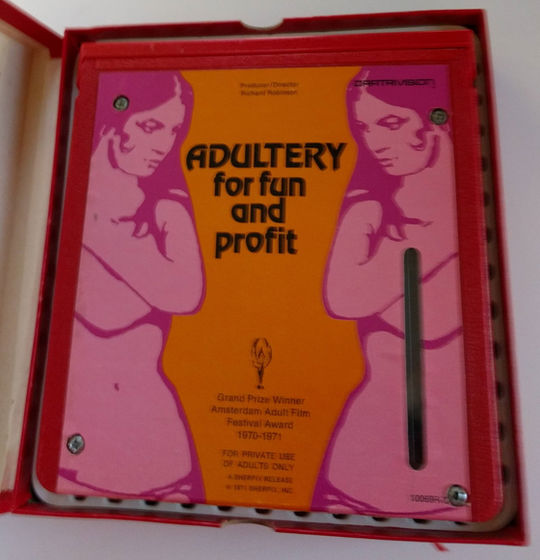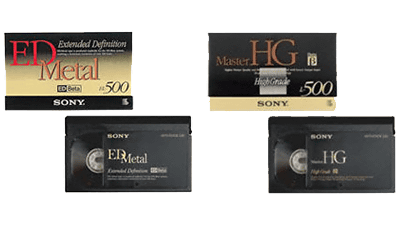What videocassettes do you own but can't watch?

'There are video cassettes that I own but can't watch,' confesses programmer
Foone Turing — FUN FACT: I own porn I can't watch.
https://foone.tumblr.com/post/705446706461949953/hello-hacker-news-never-post-me-on-your-site-ever
Released in 1971, the X-rated movie ' Adultery for Fun & Profit ' (currently NC-17 , equivalent to R18+ in Japan) won the grand prize at the Amsterdam Adult Film Festival held in Amsterdam, the Netherlands at the time. It's a masterpiece.
Mr. Turing, a programmer, owns a cart revision of such a masterpiece movie.

Cart Revision was announced in 1970, and although it was released in June 1972, it was an early home video cassette format that was discontinued in July 1973, just 13 months later. Kart Revision did not sell dedicated VCRs, only TVs and VCRs in one. Also, it seems that the television with the video deck for the cart revision was huge even in the 1970s.
The following is one of the televisions integrated with such a cart revision dedicated video deck.

When Kart Revision came out in the early 1970s, the movie industry was still making a lot of money from people who went to theaters. Therefore, the idea of 'watching movies at home' was hated by the movie industry. The reason for this is very simple: ``If you can watch movies at home, the number of people who go to the theater will decrease.'' This idea later led to the movie industry suing Sony when Sony released
Therefore, when Cartridge was released in 1972, it seems that no movie studio wanted to sell movies with Cartridge. As a result, Cartridge licensed a black-and-white movie from PBS , a public broadcasting service. In addition, he seems to have sold images that would be a compromise for movie studios, such as sports, at cart revision.
Cart revisions existed in two forms called black tape and red tape. Like other products, black tape was purchased at a retail store and owned by the user, but the red tape, which is relatively newer than black tape, was ordered from a retail store's catalog and delivered to the house by mail at a later date. It seems that it was for rental to return to the store after watching something.
In addition, the red tape had mechanical differences from the black tape. That is the point that it cannot be rewound. Red tape can be played, paused, and stopped, but cannot be rewound. So once you start watching a movie, you can't rewind it, and if you want to watch it again, you have to rent it again.

When the Cart Revision went out of production in July 1973, many retailers sold the unsold Cart Revision at low prices in stock sales. At that time, many of the people who purchased Cartridges had televisions with built-in VCRs. However, those who have purchased the Red Tape find that the tape cannot be rewound.
So, some of the people who bought the red tape tried to figure out how the mechanism works by turning the screw holes in the four corners of the package with a screwdriver to dismantle the cart revision and make it impossible to rewind. It seems that Therefore, it seems that most of the red tape sold on auction sites like eBay has visible screw holes.
Turing's cart revision 'Adultery for Fun & Profit' also has screw holes in the four corners.

At the time of writing the article, it is very difficult to obtain a video deck, because the cart revision basically had only a video deck integrated TV. Also, Turing points out that the cartridge itself is old and brittle, and even if you have a video deck, the tape may shatter into pieces when you try to play it. In addition, citing that the cart revision was produced for a short period of only 13 months, Turing pointed out that ``the number of cart revisions is very small in the first place.''
Cart Revision was the first home videocassette format for recording television. A fan who had a cart revision from that time succeeded in recording the NBA Finals Game 5 (Los Angeles Lakers vs. New York Knicks) of the 1972-1973 season . ABC News , the Los Angeles Lakers and the New York Knicks all had recordings of the game, but all three lost them, making fan-recorded Game 5 footage invaluable. It is assumed that However, it seems that the fifth game recorded with this cartridge will be broken into pieces when trying to play it back, and it seems that it was a 'tape that can not be played back' after all.
So DuArt Media Services burns, freezes, dries out, soaks in alcohol, repairs broken components, and manually captures footage successfully captured from tape to digital. We are trying to restore the recorded video in various ways, such as repairing with.
The footage of the NBA Finals and Round 5 was very valuable in the first place, and it was very difficult to restore the footage from the cart revision, so it was decided to create a documentary video summarizing the series of events.
The name of this documentary video is 'Lost and Found' and has won the Emmy Award . However, Lost and Found seems to exist almost nowhere at the time of article creation, and there is only a short excerpt video on Vimeo.
Lost & Found '73 Knicks Championship Tape Excerpt: Intro on Vimeo
As mentioned above, the number of production was small in the first place, and since more than 50 years have passed since the cassette was produced, it is extremely fragile and cannot be played, and there are almost no video decks for playback. , Turing said, ``Kartivision is just as good as dead.Although it has not been forgotten yet, it took a long time and a lot of effort by experts to restore a few minutes of video from one tape. Given that, the possibility of my 'Adultery for Fun & Profit' being played is zero.'
Related Posts:






